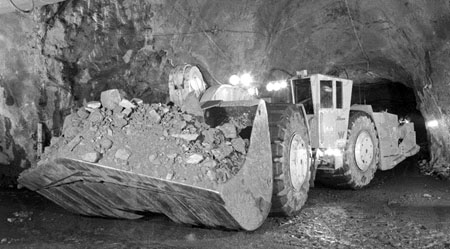Underground mining (hard rock)
Underground mining (hard rock)
Underground hard rock mining refers to various underground mining techniques used to excavate hard minerals such as those containing metals like gold, copper, zinc, nickel and lead or gems such as diamonds. In contrast soft rock mining refers to excavation of softer minerals such as coal, or oil sands.
Mine Access
Underground Access
Accessing underground ore can be achieved via a decline (ramp), vertical shaft or adit. Declines can be a spiral tunnel which circles either the flank of the deposit or circles around the deposit. The decline begins with a box cut, which is the portal to the surface. Depending on the amount of overburden and quality of bedrock, a galvanized steel culvert may be required for safety purposes.
Shafts are vertical excavations sunk adjacent to an ore body. Shafts are sunk for ore bodies where haulage to surface via truck is not economical. Shaft haulage is more economical than truck haulage at depth, and a mine may have both a decline and a ramp. Adits are horizontal excavations into the side of a hill or mountain. They are used for horizontal or near-horizontal ore bodies where there is no need for a ramp or shaft. Declines are often started from the side of the high wall of an open cut mine when the ore body is of a payable grade sufficient to support an underground mining operation but the strip ratio has become too great to support open cast extraction methods.

Ore Access
Levels are excavated horizontally off the decline or shaft to access the ore body. Stopes are then excavated perpendicular (or near perpendicular) to the level into the ore.
Ventilation
Door for directing ventilation in an old lead mine. The ore hopper at the front is not part of the ventilation.One of the most important aspects of underground hard rock mining is ventilation. Ventilation is required to clear toxic fumes from blasting and removing exhaust fumes from diesel equipment. In deep hot mines ventilation is also required for cooling the workplace for miners. Ventilation raises are excavated to provide ventilation for the workplaces, and can be modified to be used as escape routes in case of emergency.The main sources of heat in underground hard rock mines are virgin rock temperature, machinery, auto compression, and fissure water although other small factors contribute like people breathing, inefficiency of machinery, and blasting operations.
Cut and Fill mining is a method of short hole mining used in narrow ore zones. An access ramp is driven off the main level to the bottom of the ore zone to be accessed. Using development mining techniques a drift is driven through the ore to the defined limit of mining. Upon completion the drift (or "cut") is filled back to the access ramp with the defined type of backfill, which may be either consolidated or unconsolidated. Another drift is driven on top of filled cut. This process continues until the top of the stope is reached.
Drift and Fill is similar to cut and fill, except it is used in ore zones which are wider than the method of drifting will allow to be mined. In this case the first drift is developed in the ore, is backfilled using consolidated fill. The second drift is driven adjacent to the first drift. This carries on until the ore zone is mined out to its full width, at which time the second cut is started atop of the first cut.
Room and Pillar mining : Room and pillar mining is commonly done in flat or gently dipping bedded ore bodies. Pillars are left in place in a regular pattern while the rooms are mined out. In many room and pillar mines, the pillars are taken out starting at the farthest point from the stope access, allowing the roof to collapse and fill in the stope. This allows a greater recovery as less ore is left behind in pillars.
Block Caving such as is used at the Northparkes Mine in NSW, Australia, is used to effect with large sized orebodies which are typically composed of low-grade, friable ore. The method works best with cylindrical, vertical orebodies. Pre-production mining development work consists of driving accesses underneath the orebody. This includes the formation of "drawbells" by undercutting and blasting. Initially, blasted ore is removed via the extraction level underneath the drawbells until a sufficient area of unsupported ore is formed that the orebody begins to fracture and cave on its own. The eventual aim of the block caving method is that the friable ore needs no blasting and continues to fracture and break up on its own, flowing down the drawbells to the extraction level, where it is removed from the ore chute mouths with loaders and sent off for processing. Eventually the fracturing will propagate to the surface, resulting in subsidence.

One of the main hazards associated with block-caving is that fracturing can potentially stop before it reaches the surface unbeknownst to the people in control of the mine. If fracturing stops propagating upwards and extraction continues, a large void can be formed, resulting in the potential for a sudden and massive collapse and catastrophic windblast throughout the mine.








